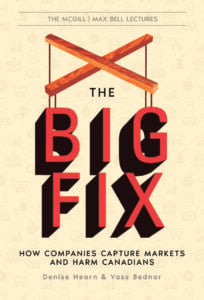“Everything companies”: How Amazon’s playbook is reshaping competition in Canada
In this excerpt from The Big Fix, authors Denise Hearn and Vass Bednar argue companies increasingly want to collect assets across industries.
Advertisement
In this excerpt from The Big Fix, authors Denise Hearn and Vass Bednar argue companies increasingly want to collect assets across industries.

Canadian companies are nowhere near the size and scale of Amazon, but some of our most beloved brands now see themselves less as industry leaders and more as collections of varied financial assets. Consumers think of companies as offering goods and services, but this is not necessarily how companies think of themselves, as they increasingly use convoluted accounting and tax practices that primarily seek to return capital to shareholders. In this way, companies no longer invest in production; they are investment companies. The term for this is “financialization,” and it is key to global capitalism today.
Greta Krippner, a scholar at the University of Michigan, defines financialization as “a pattern of accumulation in which profit making occurs increasingly through financial channels rather than through trade and commodity production.”
This pattern of financialization becomes evident when we look at the history of one of Canada’s most storied companies: The Hudson’s Bay Company (HBC).
HBC was Canada’s original monopolist. Here’s how the company’s own website describes it:
In 1670, the [British] Royal Charter granted HBC a trading monopoly over the territories that contained rivers that flowed into Hudson Bay. That control was eventually extended from Labrador to the Pacific, from the Pacific Northwest to the Arctic Ocean, an area approximating one twelfth of the Earth’s land mass.
Once a titan of fur trading and mercantile outposts, the company modernized over time, and the firm was acquired by an American private equity firm in 2008. Despite numerous changes in ownership over the last 15 years, today, the Bay is privately owned by an American businessman named Richard Baker, who is HBC’s current governor and chairman. While consumers conceptualized Hudson’s Bay primarily as a retail store representing Canadian trade history, that’s not how Baker sees it: “We’re not a department store chain. We’re a holding company that owns many billions of dollars of real estate,” Baker said in a 2020 Globe and Mail interview. In fact, the retail stores only account for about 15% of the company’s value, according to Baker.
In other words, the Bay was a department store. Today, the Bay has a department store.
The entity known as The Bay is the online business of Hudson’s Bay Company. Physical stores have retained the Hudson’s Bay name. HBC owns Zeller’s, Saks and Home Outfitters, and they sell at least 12 private label brands. HBC also offers a Mastercard and supports a loyalty program (Hudson’s Bay Rewards). Finally, it owns and operates an online marketplace that is conceptually similar to Amazon. This e-commerce arm can similarly elevate or preference the firm’s own brands against those of third-party competitors and incentivize shoppers to spend more through the Hudson’s Bay Rewards program.
Today, Hudson’s Bay is a company with a diverse set of financial and physical assets that it tries to combine to increase its profit position. Amazon, Walmart, and Costco have decimated many retailers, and companies like Hudson’s Bay have been forced to diversify their assets to stay competitive. As retail has continued to struggle post-pandemic, HBC has been closing some of its most iconic and beloved stores across Canada.
Companies need to diversify their revenue streams and evolve as market conditions shift, so these changes are not necessarily a bad outcome. But the evolution of Hudson’s Bay represents the financialization that has changed so much of firm operations today. HBC’s owners live outside of Canada, its shareholders are increasingly institutions, and the value of the company consists of collecting financial assets with market value, rather than the productive utilization of those assets for consumers.
This way of thinking about a company’s value isn’t necessarily new. Ray Kroc, the founder of McDonald’s, is said to have once asked a group of MBA students to tell him what business they thought he was in. They volunteered that he was in the hamburger business. He countered that, “My business is real estate.” Similarly, Baker describes HBC primarily as “an investment company at the crossroads of real estate, operating companies and digital companies.”
Similarly, Canadian Tire is typically thought of as a retailer, but its ecosystem is more complex than most people may appreciate, as their suite of assets extends beyond their most recognisable store. Over time, the firm’s acquisitions of Mark’s (formerly Mark’s Work Wearhouse), Party City, the Helly Hansen apparel brand, and SportChek have allowed the firm to combine assets in retail, automotive and gasoline, financial services and specialty brands, enhancing the firm’s retail footprint and strengthening its market position across multiple sectors.
The company is also known for its paper Canadian Tire money, first introduced in 1958, an early cash rewards loyalty program. Using its own pseudo-currency made the store feel like a board game come to life and was extremely popular. Today, Canadian Tire money is digital, and the Canadian Tire Bank has been licensed under the Banking Act since 2003. Canadian Tire Financial Services is a subsidiary of the company and now offers credit cards, insurance products, and other financial services. So, is Canadian Tire a bank, an insurer, or a retailer? It’s all of the above. And this plays a significant role in driving loyalty, measured by the frequency and amount that the consumer spends through their Triangle Rewards program, which replaced Canadian Tire Money in 2018.
Investors can even invest in Canadian Tire’s collection of real estate holdings through a REIT (real estate investment trust) through the Toronto Stock Exchange. The REIT owns the buildings and land that Canadian Tire (and other of its retail brands) lease from them. The contracts stipulate that the REIT is entitled to annual rent increases.
The collection of these assets and subsidiaries creates a mutually reinforcing flywheel for the business. It also complicates the definition of Canadian Tire’s relevant marketplace. How should an analyst account for the gas stations and convenience stores owned by Canadian Tire Petroleum, where people collect points and other incentives through Triangle Rewards? Or PartSource, the specialty automotive parts retailer owned by Canadian Tire? The same question is raised with Mark’s (clothing and footwear), SportChek (sports apparel), Helly Hansen (outdoor apparel) or Party City (party supplies). The more diverse holdings a company has, the more difficult it can be to value the company.
Overly simplistic calls for more competition miss this critical point and simplify an increasingly complex set of economic questions. More and more companies are moving from competing within industries to competing to accumulate vast ecosystems of assets. Trying to put companies into neatly defined buckets or industries misses the point. Commerce is a complex web of relationships among many different stakeholders. Just when you think you’ve wrapped your mind around it, a company can shape-shift and confound a rigid sectoral definition.
Companies increasingly want to insert themselves into every aspect of our daily lives, enveloping us in their ecosystem. As we go about our daily lives, everything we do becomes a cash-out opportunity, and we transfer a bit of our paycheque to a monopolist or oligopolist. Industries, be gone. We are the asset.

Excerpted from The Big Fix: How Companies Capture Markets and Harm Canadians by Denise Hearn and Vass Bednar. Copyright 2024. Reprinted by permission of Sutherland House Books.
Denise Hearn is an author, applied researcher and advisor focused on how economic power and paradigms shape our world. She is a resident senior fellow at Columbia Centre on Sustainable Investment at Columbia University.
Vass Bednar is the executive director of McMaster University’s Master of Public Policy in Digital Society program. Her work focuses on the intersections between policy and the innovation ecosystem.
Share this article Share on Facebook Share on Twitter Share on Linkedin Share on Reddit Share on Email